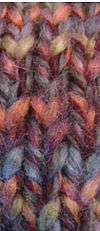Steek
In knitting, steeking is a shortcut used to knit garments such as sweaters in the round without interruption for openings or sleeves until the end. After completing a tube, a straight line is cut along the center of a column of stitches, in order to make room for an opening or place to attach another piece. The steek itself is a bridge of extra stitches, in which the cut is made, and is usually 6-10 stitches wide. This technique was developed by the knitters of the Shetland archipelago and is particularly associated with Fair Isle sweaters, although it can be used for solid colors as well.
After the steek is cut, the edges are tacked down on the wrong side of the fabric in order to create a neat finishing, or the adjacent stitches are sewn or crocheted together to prevent unraveling. The stitches can also be picked up and knit from, for example, to create a sleeve. Alternatively, a sleeve can be made separately and sewn onto the steek. After the garment with a steek has been worn and washed a few times, the facings will full and become durable finishes on the inside of the garment.
Steeks can be used for front openings (such as on a cardigan), armholes, or necklines. It has several advantages: Many knitters are faster at the knit stitch than the purl stitch, it goes faster, and allows one to work with the right side of the fabric facing the knitter all the time, and thus follow an intricate pattern more easily. It is also easier to maintain an even tension and, as the color changes can be hidden, there are fewer ends to weave in.
In general, there is little risk of unravelling the sweater with a steek cut if the sewn or crocheted line has been done with wool yarn that is not superwash. They can be further strengthened by using a sticky hairy animal yarn (Shetland wool, the traditional choice, is a good example), and using frequent color changes (such as a 1x1 rib or a check pattern) to secure the yarn. In addition, the sides of the steek can be reinforced by crocheting or sewing.
Steeking is a procedure used in the making of Scottish traditional kilts in which the pleats of the kilt are "steeked," or stabilized, by a line of running stitches made from the wrong side of the fabric, just above the ending line of pleats, or "fell." Steeking is done after cutting extra fabric away at the top of the pleats, and before the kilt is pressed and other finishing elements like lining and buckles are applied. For more on kilt making, see this site.
References
- Jang, Eunny. "Steeks: Cutting the Edge", in Interweave Knits, Winter 2006. Loveland, Colorado: Interweave Press, pages 100-104.
